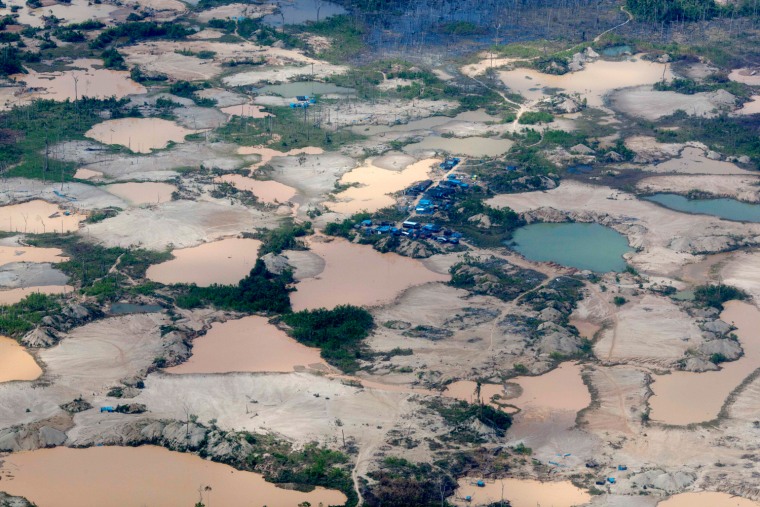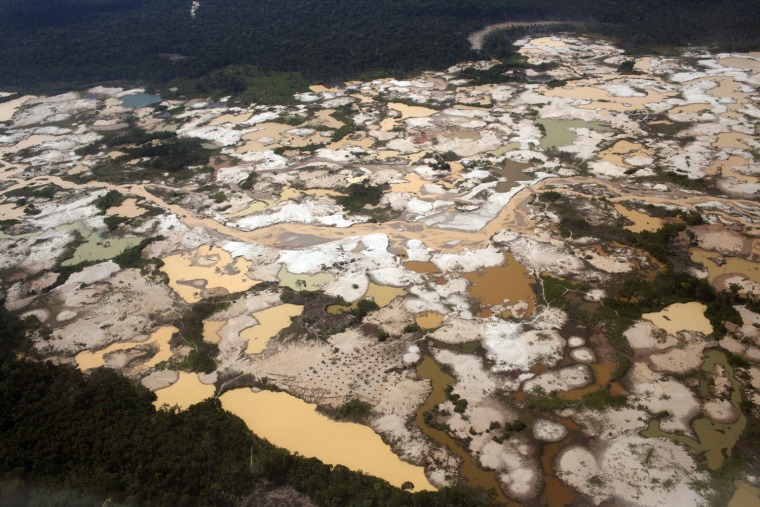LIMA, Peru — The ravaging of the Peruvian Amazon by a wave of illegal gold mining is twice as bad as researchers had thought.
That is according to a new study using groundbreaking technology that’s discovered thousands of previously undetected small mines in the Madre de Dios region of Peru, near the Bolivian border, a global biodiversity hotspot.
Thanks to its stunning wildlife, the region is home to various nature and indigenous reserves and dozens of thriving jungle lodges that welcome tourists from around the world.
Yet it’s also experienced widespread devastation since the 2008 global financial crisis saw gold prices rocket. Thousands of miners have flooded into the region, dredging riverbeds and carving up vast tracts of the forest floor in remotes areas beyond the reach of the authorities.
They have also poisoned the water table for miles around by dumping hundreds of tons of mercury, which miners use to extract gold from the soil.
According to the report, by the Carnegie Institution for Science and published in the Proceedings of the National Academy of Sciences, the mining has cleared 15,180 acres of forest per year since 2008 — twice previous estimates. That’s roughly the size of 20 Central Parks.
The researchers made their discovery thanks to new technology including LiDAR, a laser mounted on a plane overflying the Amazon that creates 3D maps of the forest in far greater detail than anything previously achieved.

“Our results reveal far more rainforest damage than previously reported by the government, NGOs, or other researchers,” said Greg Asner, the American scientist who led the study, in a statement.
“The gold rush in Madre de Dios exceeds the combined effects of all other causes of forest loss in the region, including from logging, ranching and agriculture,” he added.
“This is really important because we are talking about a global biodiversity hotspot. The region’s incredible flora and fauna is being lost to gold forever.”
Ernesto Raez Luna, from Peru’s Environment Ministry and co-author of the report with Asner, added: “We are using this study to warn Peruvians on the terrible impact of illegal mining in one of the most important enclaves of biodiversity in the world, a place that we have vowed, as a nation, to protect for all humanity.
“Nobody should buy one gram of this jungle gold. The mining must be stopped.”
Twice the size of California, the Peruvian Amazon is one of the largest surviving stretches of tropical rainforest anywhere on Earth.
It’s home to a staggering array of plants, fish, birds, mammals, reptiles and amphibians. And its trees warehouse vast quantities of carbon that contribute to global warming when the jungle is destroyed.
While many of the gold miners are poor locals desperate to support their families, others are wealthy businessmen using expensive mechanical diggers and even large boats to dredge riverbeds.
Police have raided some of the largest mining camps, where a Wild West atmosphere of guns and liquor rules. They have also blown up mining equipment and freed underage girls being forced to work in brothels, yet they have rarely been able to catch the miners working deeper in the jungle.
This story originally appeared on GlobalPost.
More from GlobalPost
